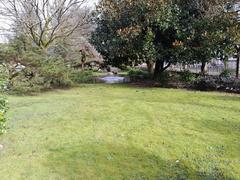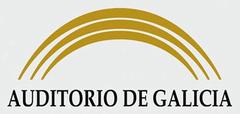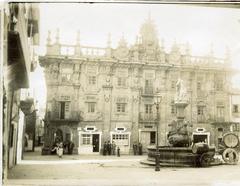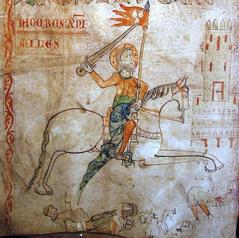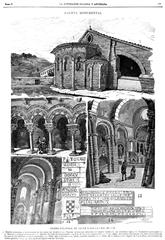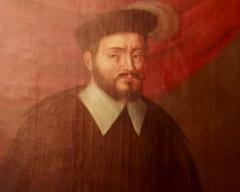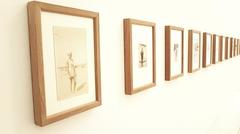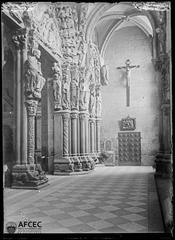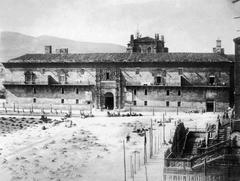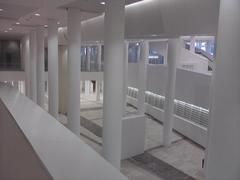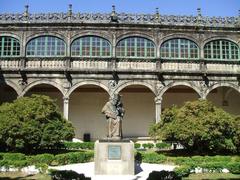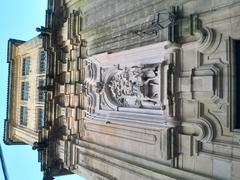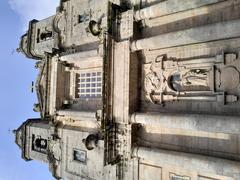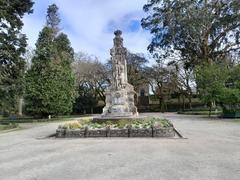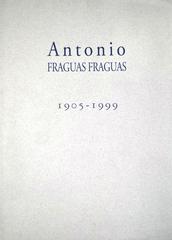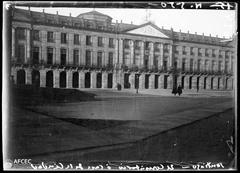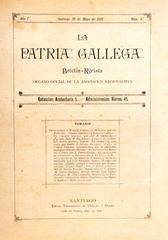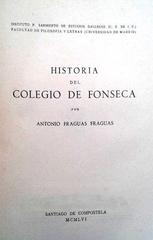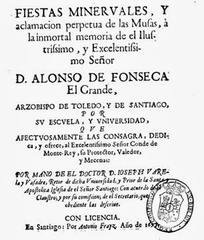
Fachada Do Obradoiro, Catedral De Santiago De Compostela
Fachada do Obradoiro: Visiting Hours, Tickets, and Santiago de Compostela Historical Sites Guide
Date: 04/07/2025
Introduction
The Fachada do Obradoiro, the grand Baroque western façade of the Catedral de Santiago de Compostela, is one of Spain’s most celebrated architectural landmarks. Overlooking the bustling Praza do Obradoiro, it marks the culmination of the historic Camino de Santiago pilgrimage and serves as both a spiritual beacon and a masterpiece of artistic heritage. Designed by Fernando de Casas Novoa and completed in 1750, the façade is renowned for its dynamic Baroque ornamentation, soaring towers, and intricate statuary depicting Saint James and other biblical figures. This guide delves into the history, architecture, cultural significance, and practical visitor information for the Fachada do Obradoiro, ensuring you make the most of your visit to Santiago de Compostela (Fundación Jacobea; Ultreya Tours; viajecaminodesantiago.com; thetouristchecklist.com).
Table of Contents
- Historical Background and Evolution
- Architectural Features and Symbolism
- Integration with the Plaza del Obradoiro
- Preservation and Restoration
- Visiting Information: Hours, Tickets, and Accessibility
- Travel Tips and Nearby Attractions
- Visitor Experience and Practical Advice
- Frequently Asked Questions (FAQ)
- Summary and Key Takeaways
- References and Links
Historical Background and Evolution
Medieval Origins
The origins of the Catedral de Santiago de Compostela trace back to the 9th century, following the discovery of the tomb of Saint James the Great. The initial Romanesque cathedral, begun in 1075 and completed in 1211, was built to accommodate the growing influx of pilgrims. The original western façade was Romanesque and austere, with the famed Pórtico da Gloria by Maestro Mateo (completed in 1188) as its main entrance for arriving pilgrims (Wikipedia).
Baroque Transformation
By the 17th and 18th centuries, both architectural taste and the cathedral’s status had evolved. The weathered Romanesque façade was replaced with a grander Baroque one to better protect the Pórtico da Gloria and to impress the increasing number of pilgrims. Fernando de Casas Novoa led the Baroque redesign starting in 1738, culminating in the monumental façade seen today. His design introduced verticality, dynamic movement, and elaborate ornamentation, hallmarks of Spanish Baroque (Ultreya Tours).
Architectural Features and Symbolism
- Twin Towers: The Torre de las Campanas (right) and Torre de la Carraca (left) frame the façade, rising approximately 74 meters. These towers serve both functional and symbolic purposes, acting as beacons for pilgrims (Ultreya Tours).
- Central Statuary: The centerpiece is Saint James the Greater, depicted as a pilgrim and flanked by Spanish kings and angels bearing the cross of Santiago.
- Ornamentation: Elaborate balustrades, statues of apostles and saints, and abundant Baroque detail adorn the façade.
- Grand Staircase: Added in the 17th century, the double staircase facilitates the flow of pilgrims and dignitaries.
- Symbolic Program: The upward progression of the façade and the profusion of religious imagery symbolize the spiritual journey, with Saint James guiding pilgrims toward salvation (viajecaminodesantiago.com).
Integration with the Plaza del Obradoiro
The façade and the Praza do Obradoiro are inseparable in both function and symbolism. The square, a monumental rectangle, is the architectural and civic heart of Santiago de Compostela. It is bordered by the cathedral, the Hostal dos Reis Católicos (now a luxury hotel), the Pazo de Raxoi (city hall), and the Colegio de San Jerónimo (university). The eight-rayed pattern of the cobblestones represents the convergence of pilgrimage routes from across Europe (Wikipedia; Fundación Jacobea).
Preservation and Restoration
The Fachada do Obradoiro has undergone various restoration efforts to address weathering and structural concerns. The most recent campaigns have focused on cleaning, stabilizing sculpture, and improving drainage to preserve the intricate granite details (Ultreya Tours; viajecaminodesantiago.com).
Visiting Information: Hours, Tickets, and Accessibility
Visiting Hours
- The cathedral is generally open 7:00 AM – 8:30 PM year-round. Hours may vary during religious events and holidays (caminosantiagocompostela.com).
- The main façade doors are open only during special liturgical events; regular entry is via the Platerías façade.
- Night visits with special illumination are sometimes available.
Tickets
- Entry to the cathedral nave is usually free.
- Tickets (approx. €3–€12) are required for access to the museum, Pórtico da Gloria, and rooftop tours. Discounts apply for children, seniors, and pilgrims (thetouristchecklist.com).
- Tickets are best purchased in advance online or at the ticket office in Praza do Obradoiro.
Accessibility
- The main entrance and square are accessible to visitors with reduced mobility; ramps and adapted facilities are provided, though some historic areas may be less accessible.
- Audio guides are available in several languages.
Travel Tips and Nearby Attractions
- Best Times to Visit: Early mornings or late afternoons on weekdays are less crowded. Spring and early autumn offer mild weather and fewer visitors (nomads-travel-guide.com).
- Guided and Rooftop Tours: Highly recommended for deeper understanding and panoramic views. Book in advance (thenwewalked.com).
- Dress Code: Shoulders and knees covered; silence is appreciated during services.
- Nearby Sights: Explore the historic Hostal dos Reis Católicos, Pazo de Raxoi, and the charming streets and cafés of the Old Town (viajeraymochilero.com).
- Local Cuisine: Sample pulpo a la gallega (octopus) and Torta de Santiago (almond cake).
Visitor Experience and Practical Advice
- Amenities: Accessible restrooms, luggage storage, tourist office in the square, and multilingual information desks.
- Safety: Santiago de Compostela is very safe; standard precautions are advised during festivals and in crowded areas.
- Special Events: The Feast of Saint James (July 25) and Holy Years draw large crowds and feature unique religious ceremonies.
- Sustainable Tourism: Walk or use public transport, support local businesses, and minimize waste (caminosantiagocompostela.com).
Frequently Asked Questions (FAQ)
Q: What are the Fachada do Obradoiro visiting hours?
A: Generally 7:00 AM to 8:30 PM, but check the official cathedral website for current schedules.
Q: Do I need tickets to visit the Fachada do Obradoiro?
A: The façade and main nave are free to visit; tickets are necessary for the museum, rooftop, and special tours.
Q: Is the cathedral accessible for visitors with disabilities?
A: Yes, main entrances and facilities are accessible, though some historic areas may pose challenges.
Q: Are guided tours available?
A: Yes, in multiple languages. Rooftop tours may not always be in English—check in advance.
Q: When is the best time to visit?
A: Early morning or late afternoon outside peak season (spring or early autumn) for fewer crowds.
Q: Can I take photographs?
A: Photography is allowed of the façade and in the square; restrictions may apply inside during services.
Summary and Key Takeaways
The Fachada do Obradoiro stands as a testament to Santiago de Compostela’s enduring spiritual, cultural, and artistic legacy. Its Baroque splendor, intricate symbolism, and integration with the heart of the city make it a must-see for pilgrims and travelers alike. Plan ahead for tickets and guided tours, respect the site’s religious nature, and take time to appreciate the façade at sunrise or sunset for the best views. The surrounding historic center offers a blend of tradition, hospitality, and vibrant Galician culture. For up-to-date information and audio guides, consider the Audiala app when planning your visit (Ultreya Tours; Fundación Jacobea).
References and Links
- Fundación Jacobea
- Ultreya Tours
- viajecaminodesantiago.com
- Wikipedia - Plaza del Obradoiro
- thetouristchecklist.com
- caminosantiagocompostela.com
- nomads-travel-guide.com
- catholicshrinebasilica.com
- thenwewalked.com
- viajeraymochilero.com
For more travel tips, virtual tours, and up-to-date information, download the Audiala app and explore our related articles on Spanish Baroque architecture, the Camino de Santiago, and Galician culture.






